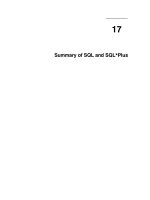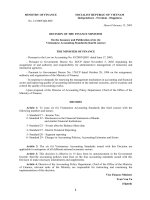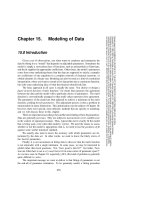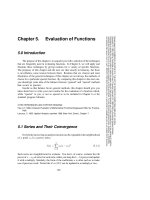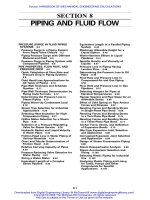Tài liệu Art of Surface Interpolation-Chapter 1: Introduction doc
Bạn đang xem bản rút gọn của tài liệu. Xem và tải ngay bản đầy đủ của tài liệu tại đây (2.18 MB, 12 trang )
Art of Surface Interpolation
Mgr. Miroslav Dressler, Ph.D.
KUNŠTÁT, 2009
1
Preface
The following text is based on my twenty years experience in developing a surface in-
terpolation algorithm and five years experience with solving surface interpolation prob-
lems provided by people all over the world.
The success of interpolation and quality of the resulting surface depends on the config-
uration of input data, the selected method, parameters of interpolation, grid size and so
on. From this point of view, surface interpolation can be considered as an art.
The first part describes mathematical elements of commonly used methods based on ex-
act mathematical formulations such as linear combination of radial basis functions, stat-
istical formulation of the best linear unbiased estimate or on the demand of minimal
curvature of a resulting function.
The purpose of the second part is to design and implement a new interpolation method
ABOS (Approximation Based On Smoothing), which would eliminate limitations of ex-
isting methods and which would be robust and flexible enough for interpolating any
data set, such as a complex of geological and seismic measurements, temperature distri-
bution, height of a snow layer, concentration of contaminants in an aquifer or digital
model of terrain.
The new method is not based on a mathematical definition of a resulting interpolation
function. Instead, it provides tools for modelling surface shapes – three types of numer-
ical tensioning and smoothing – enabling to achieve smooth interpolation or approxima-
tion as well as an interpolation with sharp local extremes.
2
List of symbols
Symbol Meaning
ℜ
3
three dimensional Euclidean space
XYZ sequence
{ X
i
,Y
i
, Z
i
∈ ℜ
3
, i=1, , n }
of points in 3D space
x1 , x2
minimum and maximum of x-coordinates of points XYZ
y1 , y2
minimum and maximum of y-coordinates of points XYZ
z1 , z2
minimum and maximum of z-coordinates of points XYZ
),( yxf
interpolation / approximation function
D planar domain of
),( yxf
)(h
γ
variogram function
P matrix representing grid values
i1 , j1
size of the grid = number of columns and rows of the matrix P
Dx step of the grid in the x-direction
Dy the step of the grid in the y-direction
NB matrix of the nearest points
K matrix of distances
K
max
maximal element of the matrix K
3D three-dimensional
RS resolution of map
Filter parameter of the ABOS method used for setting resolution
Dmc the minimal Chebyshev distance
A→B copy of the matrix (or vector or number) A into the matrix (or vector
or number) B
3
Chapter 1
Introduction
Surface interpolation and construction of maps have been traditionally used in many fields
such as physics, geophysics, geology, geodesy, hydrology, meteorology, bathymetry and so
on.
The intention of this work is to compare commonly used interpolation / approximation
methods, evaluate their advantages, insufficiencies and limitations and further to design and
to implement a new universal interpolation / approximation method which would enable to
solve a quite large class of tasks.
1.1 Formulation of the interpolation / approximation
problem
Let us denote XYZ as a sequence
{ X
i
,Y
i
, Z
i
∈ ℜ
3
, i=1,, n }
of points in 3D space and
D as a rectangular domain containing points
XY ={ X
i
, Y
i
∈ ℜ
2
, i=1, , n }
. In this
work, the solving an interpolation or approximation problem will mean the finding a con-
tinuous function of two independent variables
f x , y
, for which
f X
i
, Y
i
=Z
i
or
∣ f X
i
, Y
i
−Z
i
∣ ∀i=1,, n
respectively.
Except for trivial cases (for example approximation by a plane or by a polynomial function
of two independent variables of higher degree) it is usually not possible to express the inter-
polation / approximation function by a simple analytic formula. That is why the following
procedure is used:
The domain D containing the points XYZ is covered by a regular rectangular grid. At each
node of the grid the z-value is calculated / estimated by the method solving the above-men-
tioned problem using all points XYZ or using only the points XYZ belonging to the certain
surrounding of the node. This procedure is called gridding.
The value of the function f can then be computed, for example, using the bilinear equation
f x , y=a⋅xyb⋅xc⋅yd
, where the coefficients a, b, c and d are determined by the
corner points of the grid rectangle containing the point
),( yx
.
1.2 Commonly used approaches to solution
The goal of this section is to present commonly used techniques for solving interpolation /
approximation problems and to evaluate their applicability for the solving practical tasks.
The below presented interpolation / approximation methods are:
- Triangulation with linear interpolation
- Natural neighbour
- Inverse distance
- Minimum curvature
- Regression by plane with weights
- Radial basis functions
- Kriging
Modification of these methods for solving large problems is described in the last paragraph
of this chapter.
4
1.2.1 Triangulation with linear interpolation
The method of triangulation with linear interpolation is historically one of the first methods
used before the intensive development of computers. It is based on the division of the do-
main D into triangles. Each triangle then defines, by its three vertices, a plane – that is why
the resulting surface is per partes linear.
Advantages:
- very fast algorithm
- resulting surface is interpolative
Disadvantages:
- the domain of the function f is limited to the convex envelope of the points XYZ.
- resulting surface is not smooth and isolines consists of line segments
- the division into triangles may be ambiguous, as the following simple example of alternat-
ive division of rectangle shows – in the first case a valley was created, in the second case a
ridge was created.
Fig. 1.2.1: Alternative division of rectangle into triangles.
Application:
This method is still used in geodesy and digital models of terrain. As a rule, characteristic
points of terrain are measured – it means that the person performing terrain measurements
surveys only points where the slope of terrain changes (tops, edges, valleys and so on) and
thus avoids the above-mentioned ambiguity. For interpretation of such data, the Triangula-
tion with linear interpolation method is quite suitable.
1.2.2 Natural neighbour
The Natural neighbor is an interpolation method based on Voronoi tessellation. Voronoi
tessellation can be defined as “the partitioning of a plane with n points into n convex poly-
gons such that each polygon contains exactly one point and every point in a given polygon
is closer to its central point than to any other” (see [S11]). In other words, if
{ X
i
}
i=1
n
is a
given set of points in
ℜ
2
, than the Voronoi polygon corresponding to the point X
i
is the set
V
i
={ X ∈ ℜ
2
;∣X , X
i
∣∣X , X
m
∣ ∀m≠i }
.
A description of the natural neighbor interpolation technique follows:
Given a set of data points distributed on a plane, natural neighbour interpolation computes
the interpolated value for a given point X as the weighted sum of the points which are natur-
al neighbors of X. The natural neighbors can be intuitively understood as those points which
would be adjacent to X in a Voronoi tessellation of the point set including X.
5
Figure 1.2.2 depicts with black lines a Voronoi tessellation of the points A, B, C, D and E.
The gray region marks the new Voronoi cell, which would be present if the point X were in-
cluded in the tessellation. The weights of points A, B, C, D and E which are used to com-
pute the interpolated value of X are respectively the areas of the grey region intersecting
each original cell of A, B, C, D and E and are also known as the natural neighbor coordin-
ates of X.
Fig. 1.2.2: New Voronoi cell and areas for computation of neighbor point weights.
The surface formed by natural neighbour interpolation has the useful properties of being
continuous (C0) everywhere and passing exactly through z values of all data points.
Moreover, the interpolated surface is continuously differentiable (C1) everywhere except at
the data points, providing smooth interpolation in contrast to the Triangulation with linear
interpolation method.
Advantages:
- fast algorithm
- resulting surface is interpolative and smooth except at the data points.
Disadvantages:
- the domain of the function f is limited to the convex envelope of the points XYZ
- the shape of the resulting surface is not acceptable in some fields such as in geology or
hydrogeology.
Application:
The Natural neighbour method is mainly used in GIS systems as a digital model of terrain
and fast interpolation of terrain data providing a smooth surface.
1.2.3 Inverse distance
This method computes a value of function f at an arbitrary point
x , y∈D
as a weighted
average of values Z
i
:
f x , y =
∑
i=1
n
Z
i
w
i
, where
w
i
=
h
i
∑
i=1
n
h
i
,
h
i
=
1
x− X
i
2
y−Y
i
2
2
and
2
is a smoothing parameter.
If the number of points n is too great, the value of
),( yxf
is calculated only from points
belonging to the specified circle surrounding the point
),( yx
. The method was frequently
implemented in the first stages of computers development.
6
Advantages:
- simple computer implementation; for its simplicity, the method is implemented in almost
all gridding software packages
- if
2
=0
, the method provides interpolation.
Disadvantages:
- high computer time consumption if the number of points n is large (due to computation of
distances)
- typical generation of "bull's-eyes" surrounding the position of point locations within the
domain D – that is why the resulting function is not acceptable for most applications.
1.2.4 Minimum curvature method
This method and namely its computer implementation was developed by W.H.F. Smith and
P.Wessel (see [1]) in 1990. The interpolated surface generated by the Minimum curvature
method is analogous to a thin, linearly elastic plate passing through each of the data values
with a minimum amount of bending. The algorithm of the Minimum curvature method is
based on the numerical solution of the modified biharmonic differential equation
1−T ∇
4
f x , y −T ∇
2
f x , y=0
with three boundary conditions:
1.
1−T ∂
2
f /∂n
2
T ∂ f /∂ n=0
2.
∂ ∇
2
f /∂ n=0
on the edges
3.
∂
2
f /∂ x ∂ y=0
at the corners
where
T ∈ 〈0,1〉
is a tensioning parameter,
∇
2
is the Laplacian operator
∇
2
f =∂
2
f /∂ x
2
∂
2
f /∂ y
2
,
∇
4
=∇
2
2
is the biharmonic operator
∇
4
f =∂
4
f /∂ x
4
∂
4
f /∂ y
4
2∂
4
f /∂ x
2
∂ y
2
and
n is the boundary normal.
If T=0, the biharmonic differential equation is solved; if T=1, the Laplace differential equa-
tion is solved – in this case the resulting surface may have local extremes only at points
XYZ.
Advantages:
- speed of computation is high and an increasing number of points XYZ has small influence
on decreasing the computational speed.
- suitable method for a large number of points XYZ.
Disadvantages:
- complicated algorithm and computer implementation
- if the parameter T is near zero, the resulting surface may have local extremes out of the
points location
- bad ability to conserve extrapolation trends.
Application:
- universal method suitable for smooth approximation and interpolation (for example distri-
bution of temperature, water heads, potential fields and so on).
7
1.2.5 Regression by plane with weights
This method is based on regression by plane
f x , y=axbyc
using a weighted least
square fit. The weight w
i
assigned to the point
),,(
iii
ZYX
is computed as an inverse dis-
tance from point
),( yx
to the point
),(
ii
YX
. Then the minimum of the following function
of three independent variables has to be found:
F a , b , c=
∑
i =1
n
w
i
f X
i
, Y
i
−Z
i
2
=
∑
i=1
n
w
i
aX
i
bY
i
c−Z
i
2
, which leads to a solu-
tion of three linear equations:
∂ F
∂ a
=0=2
∑
i=1
n
w
i
X
i
aX
i
bY
i
c−Z
i
∂ F
∂b
=0=2
∑
i=1
n
w
i
Y
i
aX
i
bY
i
c−Z
i
∂ F
∂ c
=0=2
∑
i=1
n
w
i
aX
i
bY
i
c−Z
i
After rearrangement the following equations are obtained:
a
∑
i=1
n
w
i
X
i
2
b
∑
i =1
n
w
i
X
i
Y
i
c
∑
i=1
n
w
i
X
i
=
∑
i =1
n
w
i
X
i
Z
i
a
∑
i=1
n
w
i
X
i
Y
i
b
∑
i =1
n
w
i
Y
i
2
c
∑
i=1
n
w
i
Y
i
=
∑
i=1
n
w
i
Y
i
Z
i
a
∑
i=1
n
w
i
X
i
b
∑
i =1
n
w
i
Y
i
c
∑
i =1
n
w
i
=
∑
i=1
n
w
i
Z
i
In addition to the regression by plane, some mapping packages, for example Surfer (see
[S2]) or ConPac library (see [S10]), offer possibility to use polynomials of higher order.
Advantages:
- simple algorithm
- good extrapolation properties
Disadvantages:
- resulting function is only approximative
- slow speed of computation if n is great (due to computation of distances)
Application:
- surface reconstruction from digitized contour lines. The method was frequently used
namely in the past, when contour maps were transferred from paper sheets to digital maps.
1.2.6 Radial basis functions
The method of Radial basis functions uses the interpolation function in the form:
f x , y= px , y
∑
i=1
n
w
i
⋅∣ x , y− X
i
,Y
i
∣
(1.2.6)
where
p x , y
is a polynomial
w
i
∈ ℜ
are real weights
∣ x , y− X
i
, Y
i
∣
is the Euclidean distance between points
),( yx
and
),(
ii
YX
r
is a radial basis function
8
Commonly used radial basis functions are (c
2
is the smoothing parameter):
Multiquadric:
r =
r
2
c
2
Multilog:
r =log r
2
c
2
Natural cubic spline:
r =r
2
c
2
3 / 2
Natural plate spline:
r =r
2
c
2
⋅log r
2
c
2
The interpolation process starts with polynomial regression using the polynomial
),( yxp
.
Then the following system of n linear equations is solved for unknown weights
i
w
,
ni , ,1
=
:
Z
j
− p X
j
, Y
j
=
∑
i =1
n
w
i
⋅∣ X
j
, Y
j
− X
i
, Y
i
∣, j=1 , , n
As soon as the weights
i
w
are determined, the z-value of the surface can be directly com-
puted from equation (1.2.6) at any point
x , y∈D
.
Advantages:
- simple computer implementation; the system of linear equations has to be solved only
once (in contrast to the Kriging method, where a system of linear equations must be solved
for each grid node – see the next section)
- the resulting function is interpolative
- easy implementation of smoothing
Disadvantages:
- if the number of points n is large, the number of linear equations is also large; moreover
the matrix of the system is not sparse, which leads to a long computational time and pos-
sibly to the propagation of rounding errors. That is why this method, as presented, is used
for solving small problems with up to a few thousand points. Solving large problems is also
possible, but requires an additional algorithm for searching points in the specified surround-
ing of each grid node – see paragraph 1.2.8 Modification for solving large problems.
Application:
- universal method suitable for use in any field
1.2.7 Kriging
Kriging is an interpolation method, which was originally developed for use in geology by
D. G. Krige (see [2]), a professor at the University of Witwatersrand, South Africa, in the
1950s. In fact, the work of professor Krige is the base of science field called geostatistics.
Kriging is probably the most often used method for solving interpolation / approximation
problems, namely because it is based on the statistical formulation of the best linear un-
biased estimate. An important concept for deriving this method is empirical or experiment-
al variogram
h
:
h=
1
2
⋅
1
C N h
∑
N h
Z
i
−Z
j
2
, where
N h={i , j : ∣ X
i
,Y
i
− X
j
,Y
j
∣=h }
and
))(( hNC
is the number of elements of the
set
N h
.
For real data it is not probable that a pair of points will satisfy the condition
∣ X
i
,Y
i
− X
j
−Y
j
∣=h
and therefore for practical computation the set
)(hN
is specified
as
N h={i , j : ∣X
i
,Y
i
− X
j
,Y
j
∣ ∈ [h− h , h h ]}
9
The empirical variogram is approximated using the theoretical variogram or model. The
commonly used models are:
Linear model:
h=C
0
Sh , h≠0
where C
0
is the so called nugget effect and S is the unknown
slope.
Gaussian model:
h=C
0
C−C
0
⋅{1−exp−h
2
/a
2
}
Exponential model:
h=C
0
C−C
0
⋅{1−exp−h /a }
The Kriging method is intended for estimating the interpolation / approximation function
),( yxf
at point
),( YX
under the following assumptions:
a) The estimate Z of function
),( yxf
at an arbitrary selected point
DYX
∈
),(
can be ex-
pressed as a weighted average
Z =
∑
i=1
n
w
i
⋅Z
i
b) Sum of weights is 1:
∑
i=1
n
w
i
=1
c) The estimate of value Z is unbiased i.e. the mean
[ ]
0),(
=−
ZyxfE
.
The weights are to be computed so that the dispersion variance
)),(( ZyxfD
−
is minimal.
In the next derivation we use f instead of
),( yxf
. Taking into consideration the definition
of dispersion variance
D X =E X
2
−E X
2
and assumption c) it is obvious that we
have to minimize the expression
E [ f −
∑
i =1
n
w
i
⋅Z
i
]
2
=E [ f⋅
∑
i=1
n
w
i
−
∑
i−1
n
w
i
⋅Z
i
]
2
=E [
∑
i=1
n
w
i
⋅f −
∑
i=1
n
w
i
⋅Z
i
]
2
=
= E [
∑
i=1
n
w
i
⋅ f −Z
i
]
2
=
∑
i=1
n
∑
j=1
n
w
i
w
j
E f −Z
i
f −Z
j
From equation
E [Z
i
−Z
j
]
2
=E [ Z
i
− f f −Z
j
]
2
=E [Z
i
− f ]
2
−2 E [ f −Z
i
f −Z
j
]E [ f −Z
j
]
2
it follows that
E [ f −Z
i
f −Z
j
]=
1
2
⋅[ E [ f −Z
i
]
2
E [ f −Z
j
]
2
−E [Z
i
−Z
j
]
2
]
.
This term can be substituted into the expression which has to be minimized:
∑
i=1
n
∑
j =1
n
w
i
w
j
E f −Z
i
f −Z
j
=
∑
i=1
n
∑
j =1
n
w
i
w
j
1
2
[ E [ f −Z
i
]
2
− E [ f −Z
j
]
2
−E [ Z
i
−Z
j
]
2
]=
∑
i=1
n
∑
j =1
n
w
i
w
j
1
2
E [ f −Z
j
]
2
∑
i =1
n
∑
j=1
n
w
i
w
j
1
2
E [ f −Z
i
]
2
−
∑
i =1
n
∑
j =1
n
w
i
w
j
1
2
E [Z
i
−Z
j
]
2
10
The first two terms can be simplified:
∑
i=1
n
∑
j =1
n
w
i
w
j
1
2
E [ f −Z
j
]
2
=
∑
j=1
n
1
2
w
j
E [ f −Z
j
]
∑
i=1
n
w
i
=
∑
j=1
n
1
2
E [ f −Z
j
]
2
∑
i=1
n
∑
j =1
n
w
i
w
j
1
2
E [ f −Z
i
]
2
=
∑
i =1
n
1
2
w
i
E [ f −Z
i
]
∑
j=1
n
w
i
=
∑
i =1
n
1
2
E [ f −Z
i
]
2
The final form of the expression, which has to be minimized is:
2
∑
j =1
n
1
2
E [ f −Z
j
]
2
−
∑
i=1
n
∑
j =1
n
w
i
w
j
1
2
E [Z
i
−Z
j
]
2
=F w
1,
, w
n
If the function
), ,(
1 n
wwF
has to be minimal, the partial derivatives according to w
k
must
be zero:
∂ F /∂ w
k
=0 ∀ k=1 ,, n
It means that the following system of linear equations is obtained:
∑
i=1
n
1
2
E [ Z
k
−Z
i
]
2
w
i
=
1
2
E [ f −Z
k
]
2
, k =1,, n
The halves of means
)]([
2
1
2
ik
ZZE
−
and
)]([
2
1
2
i
ZfE
−
can be substituted by values
from the theoretical variogram. The system of equations must be completed by condition b),
i.e. the sum of weights is 1 (that is why a fictive variable
has to be added).
In the form of matrix notation the system of linear equations can be expressed as:
[
1
1 0
][
w
]
=
[
x
1
]
where
ij
=∣ X
i
, Y
i
− X
j
, Y
j
∣
and
i
x
= ∣ x , y− X
i
,Y
i
∣ , i , j =1 ,, n
.
Advantages:
- the algorithm is based on statistical formulation of the best linear unbiased estimate which
means, there is no better interpolation method from the statistical point of view.
Disadvantages:
- the weights w
i
must be computed (i.e. the system of linear equations must be solved) for
each node of the grid.
- if the number of points n is large, a large number of linear equations must be solved; that
is why this method is used for solving small problems with up to a few thousand points. For
solving large problems an additional algorithm for searching points in the specified sur-
rounding of each grid node must be implemented, as described in the next paragraph.
- the method produces undesirable “pits” and “circular” isolines in the generated surface –
see examples in paragraphs 2.4.1 Smoothness of interpolation and oscillations, 2.4.2
Shape of generated surface and 5.1 Zero-based maps.
Application:
– universal method designed especially for geology and geophysics applications.
11
1.2.8 Modification for solving large problems
Except for the Triangulation with linear interpolation and Minimum curvature method,
presented techniques need to compute horizontal distances from estimated point (grid node)
to all points XYZ. For large problems (having thousands or more points) it means increasing
of computational time, which brings necessity to reduce number of points involved into the
estimation. This is solved by specification of the surrounding which determines the set of
points included into the estimation. Of course, additional algorithm for searching of points
falling into the surrounding must be implemented.
On one hand the method can be used for large problems, but on the other hand new com-
plications are involved:
- The surrounding is usually circular (or elliptical, if an anisotropy has to be modelled)
with specified radius. In addition, implementations of gridding procedures requires
specification of maximal and minimal number of points, minimal and maximal number
of points in each quadrant (octant) and so on. It means that additional parameters influ-
encing the quality of resulting function has to be entered.
- The resulting surface may contain discontinuities (see [4]) as the set of selected points
may change while moving the estimated point from one grid node to the next. This
phenomenon is illustrated in the next chapter in the paragraph 2.4.3 Conservation of
an extrapolation trend.
- In the case of the Radial basis functions method the system of linear equation must be
completed and solved for each node of grid and the main advantage of this method is
lost.
12
